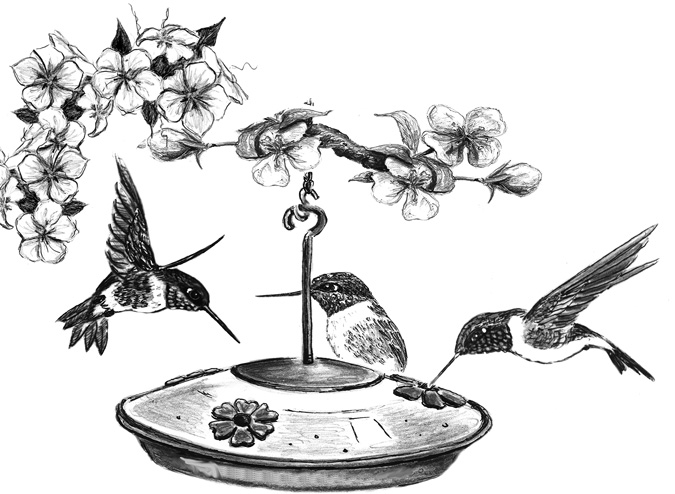
Dear Bird Folks,
You might not remember me, but last summer I asked you why I wasn’t getting any hummingbirds and you said that I may have put my feeder out too late. I don’t want to be late again this year, so when do you suggest I put my feeder out?
– Samantha, Mashpee, MA
I remember you, Samantha,
I totally remember talking with you last summer. Let’s see: it was a hot day, the sun was out, and you were wearing a hat of some kind. Am I correct? See, I told you I remembered. I have a pretty good memory, especially when it comes to bird questions. And now you say you have a problem with ducks in your attic. That’s your question, right?
Yes, putting your feeders out earlier is the best way to attract hummingbirds…and that day is coming soon. The exact date the hummers return to our area can be affected by the weather, but a good target date is the last week of this month (which is April) in case you forgot. My wife’s birthday is also at the end of April and one year I gave her a nice hummingbird feeder, which I brought home from work. Surprisingly, she wasn’t thrilled by my generous gift and told me to take it back to my shop. I told her I couldn’t because she didn’t have the receipt. Rules are rules.
The Ruby-throated Hummingbird’s spring migration starts in early February when the birds begin to leave their wintering home in Central America. It is thought that some hummers island-hop across the Caribbean, while others travel over land, pushing north along the Mexican coast and then into Texas (if they can get over the wall). However, many hummers can’t be bothered island hopping or dealing with the long Mexican coastline. Instead, they take the express route. Ruby-throated Hummingbirds are somehow able to make the nearly 500-mile non-stop flight from the Yucatan Peninsula, across the Gulf of Mexico to our southern coast. But before they make such a long journey the birds must first increase their fat reserves; they do this by gorging themselves on nectar and tiny insects. In a little more than a week’s time they are able to nearly double their body weight. (That might seem impressive for a bird, but I have relatives who pretty much do that every Thanksgiving.)
When weather conditions are favorable, the birds will take off, usually at dusk. They fly all night long, arriving on our shores the next morning. If the weather turns bad, they may not make landfall until later in the day, if they even make it at all. Occasionally, tired birds can be seen resting on offshore oil rigs, fishing boats and even cruise ships. However, they never stay on the cruise ships for long. The last thing they need is a case of norovirus.
The first migrating ruby-throats hit the southern states in late February. After recovering from their long trip across the Gulf, they slowly begin pushing north. Many other migrating bird species fly to their breeding grounds in a matter of days or even hours, but the hummers are in no hurry. They know New England is not really hummingbird friendly in February so they take their time. It is thought their migration speed is tied to the blooming of spring flowers and, of all things, Yellow-bellied Sapsuckers. Sapsuckers feed by drilling holes into trees and then eating the sweet sap as it oozes out. These sap wells make perfect refueling stations for the traveling hummers. To the birds, the sap holes are like those Waffle Houses we stop at when we’re on the road (except the Waffle Houses are stickier).
A wonderful website (hummingbirds.net) maps out the spring migration progress of Ruby-throated Hummingbirds and it’s available to anyone who wants to report the sighting of a migrating hummer. If Mary, from Peach Tree, Georgia, for example, sees her first hummer on March 16, she submits the info to the website, and then “3/16” instantly pops up on the map around Peach Tree. It’s very cool. As I type this column the map tells me that hummers have just pushed into Virginia, which is still 614 miles from Cape Cod. The birds will have to hurry if they plan on arriving here by the end of April. Will they make it on time? Yup, I’m betting they will. It’s kind of fun to watch the hummers’ daily progress on the map, but there is something else to keep in mind. Hummingbird migration is a long, protracted event. The birds are smart enough not to fly over the Gulf as one massive flock; instead they move in staggered waves. This prevents a surprise storm from wiping them all out. Staggering their departure dates also means not all of our hummingbirds will be arriving at the end of April. In fact, hummers will be streaming onto the Cape throughout them month of May. Some birds will stay and breed, but most will continue on to northern New England and the Maritimes (which I believe is someplace in Canada).
I suggest you have your hummingbird feeders out by the last week of April, Samantha. It doesn’t hurt to put them out sooner, as long as you remember to change the food every few days, regardless of bird activity (or lack thereof). By starting early you’ll probably get more birds (the hungry migrants) and you’ll also see more handsome males (they arrive a week ahead of the ladies). And in case you forget (and most people do), the formula for hummingbird nectar is four parts water to one part sugar. I’d write more on this topic but I have to go shopping for my wife’s birthday present. Hmm, I wonder what kind of birdfeeder I should get her this year.